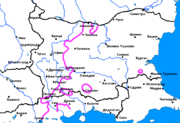
Byala Slatina-Pleven dialect
Encyclopedia

Bulgarian language
Bulgarian is an Indo-European language, a member of the Slavic linguistic group.Bulgarian, along with the closely related Macedonian language, demonstrates several linguistic characteristics that set it apart from all other Slavic languages such as the elimination of case declension, the...
dialect spoken in the regions of Pleven
Pleven
Pleven is the seventh most populous city in Bulgaria. Located in the northern part of the country, it is the administrative centre of Pleven Province, as well as of the subordinate Pleven municipality...
, Byala Slatina
Byala Slatina
Byala Slatina is a town in Northwestern Bulgaria. It is located in Vratsa Province. As of December 2009, the town has a population of 12,433 inhabitants.-External links:*...
and Kula
Kula, Bulgaria
Kula is a town in northwestern Bulgaria. It is the administrative centre of Kula Municipality part of Vidin Province. Located just east of the Serbian-Bulgarian border, it is the third largest town in the province after Vidin and Belogradchik. Kula lies 30 kilometres west of Vidin and 13...
in northwestern Bulgaria
Bulgaria
Bulgaria , officially the Republic of Bulgaria , is a parliamentary democracy within a unitary constitutional republic in Southeast Europe. The country borders Romania to the north, Serbia and Macedonia to the west, Greece and Turkey to the south, as well as the Black Sea to the east...
. The dialect is part of the Northwestern Bulgarian dialects
Northwestern Bulgarian dialects
The Northwestern Bulgarian dialects are two closely related dialects of the Bulgarian language, which are located west of the yat boundary and thus are part of the Western Bulgarian dialects. The range of the dialects includes most of northwestern Bulgaria, to the west of the line between Nikopol,...
. The most significant feature of the dialect, as in all Western Bulgarian dialects, is the pronunciation of Old Church Slavonic (yat) only as ɛ instead of formal and Eastern Bulgarian я/е (ʲa~ɛ) – бел/бели instead of бял/бели. Otherwise, the Byala Slatina-Pleven dialect bears strong resemblance to its neighbouring Eastern Bulgarian dialects and with some exceptions, mainly the pronunciation of yat
Yat
Yat or Jat is the thirty-second letter of the old Cyrillic alphabet. Its name in Old Church Slavonic is jěd’ or iad’ . In the common scientific Latin transliteration for old Slavic languages, the letter is represented by e with caron: .The yat represented a Common Slavic long vowel...
, has the same phonological and morphological features as the neighbouring subdialects of the Eastern Bulgarian Central Balkan dialect
Central Balkan dialect
The Central Balkan dialect is a Bulgarian dialect, which is part of the Balkan group of the Eastern Bulgarian dialects. Its range includes most of north-central Bulgaria , as well as the regions of Karlovo, Kazanlak and Plovdiv in southern Bulgaria, all the way down to the northernmost ridges of...
.
Phonological and morphological characteristics
- Ending (ə) (in a stressed syllable) and slightly reduced a (in an unstressed syllable) in the verbs of 1st and 2nd conjugation (as in Standard Bulgarian) - мръ, пиша
- Future tense particle ще/ше as in Standard Bulgarian and the Central Balkan dialectCentral Balkan dialectThe Central Balkan dialect is a Bulgarian dialect, which is part of the Balkan group of the Eastern Bulgarian dialects. Its range includes most of north-central Bulgaria , as well as the regions of Karlovo, Kazanlak and Plovdiv in southern Bulgaria, all the way down to the northernmost ridges of...
- ще/ше ида (I will come) - Ending schwaSchwaIn linguistics, specifically phonetics and phonology, schwa can mean the following:*An unstressed and toneless neutral vowel sound in some languages, often but not necessarily a mid-central vowel...
(ə) in stressed syllables of female nouns (as in the Central Balkan dialectCentral Balkan dialectThe Central Balkan dialect is a Bulgarian dialect, which is part of the Balkan group of the Eastern Bulgarian dialects. Its range includes most of north-central Bulgaria , as well as the regions of Karlovo, Kazanlak and Plovdiv in southern Bulgaria, all the way down to the northernmost ridges of...
) - женˈъ, горˈъ (woman, forest) - Pronunciation of the little yusYusLittle Yus and Big Yus , or Jus, are letters of the Cyrillic script, representing two Common Slavonic nasal vowels in the early Cyrillic and Glagolitic alphabets. Each can occur in iotified form , formed as ligatures with the letter Decimal I...
as (ə) - шъпа, жътва (palm, harvest) - Participles ньега/гьа for 3rd person sing. fem. agglomerative case instead of Standard Bulgarian нея/я
Most other phonological and morphological characteristics of the dialect are the same as the general features typical for all Northwestern Bulgarian dialects
Northwestern Bulgarian dialects
The Northwestern Bulgarian dialects are two closely related dialects of the Bulgarian language, which are located west of the yat boundary and thus are part of the Western Bulgarian dialects. The range of the dialects includes most of northwestern Bulgaria, to the west of the line between Nikopol,...
(cf. article for details).

